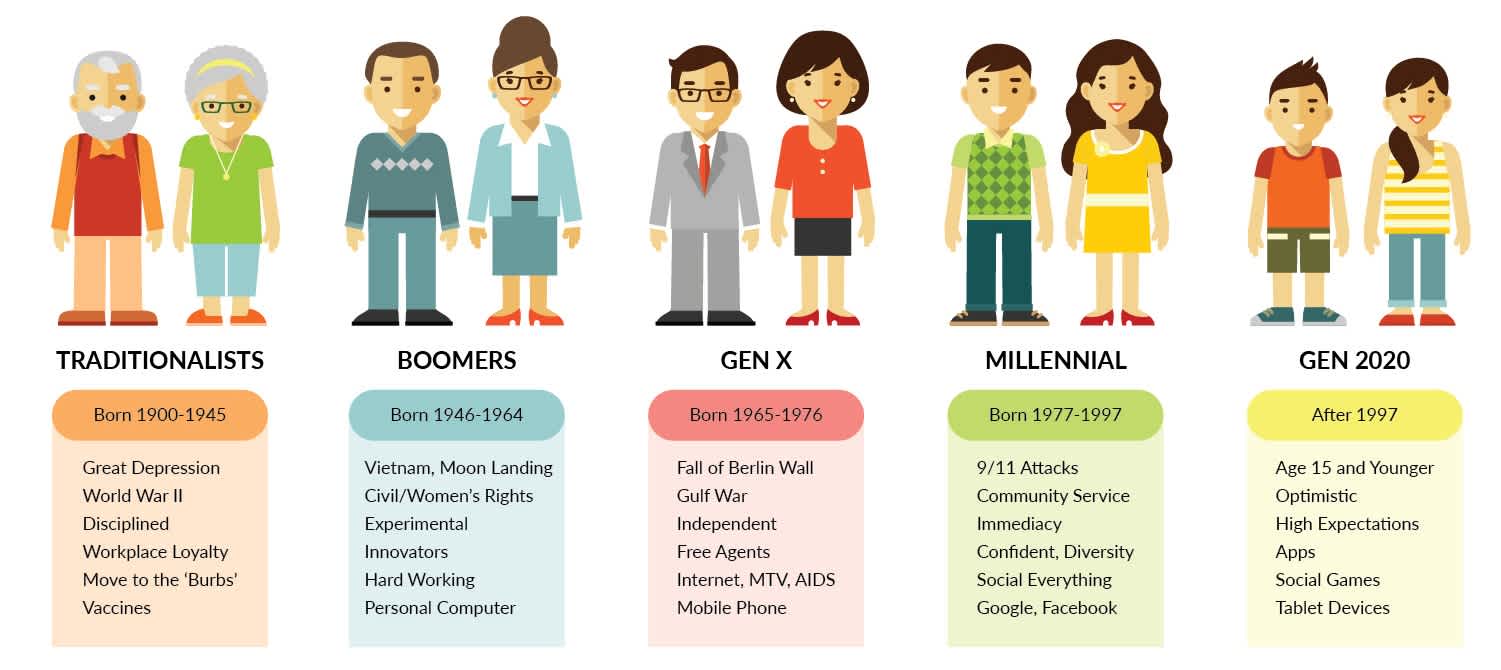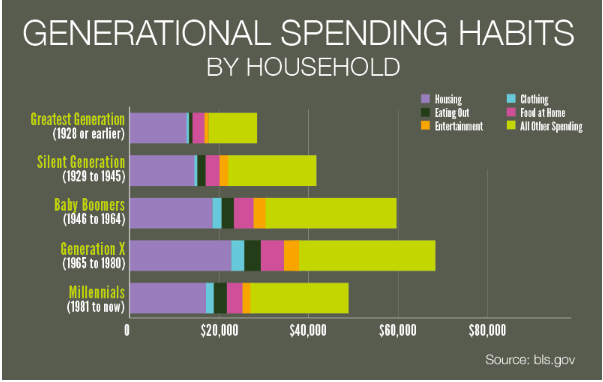//
Oct 4, 2017
Generation Marketing: How to Reach Consumers at Every Age
There’s a lot that can be said, or rather, generalized, about a person based on the generation they were born in.
Today, each generation is being targeted in some form of marketing strategy. Businesses are now implementing generation marketing strategies to ensure they effectively reach consumers at every age and life cycle.
It can often be difficult for marketers to find the best way to reach a target audience that encompasses different generations. Before diving into what makes each generation tick, let’s talk about what defines a generation.
WHAT DEFINES A GENERATION?
are groups of individuals born around the same time (usually a span of approximately 10-15 years), who have similar characteristics, preferences and values throughout their lifetime.
These groups often share preferred communication styles, buying habits and motivation triggers because they have experienced trends and events differently than other generations. Studies have shown there are three key things that have the biggest impact and influence in shaping generations–parenting, technology and economics.

Today, several generations make up the human population, including:
- Traditionalists/Materialists (born 1929-1945)
- Baby Boomers (born 1946-1964)
- Generation X (born 1965-1976)
- Millennials (born 1977-1995)
- Generation Z/Generation 2020 (born 1996 and later)
Each has certain marketing tactics they respond to better than others. To help you better understand each generation and how to target them, let’s breakdown their characteristics and differences.
UNDERSTANDING GENERATION CHARACTERISTICS
Each generation has grown up under different circumstances and lived through events that have shaped their values and the way they live life. To further understand each generation, let’s dive into different characteristics.
INFLUENTIAL EVENTS
Events throughout history impact each generation differently. While some generations live through the same events, they experience them during different periods of their lives, which impacts the generations differently.
Whether they grew up during war time, civil rights movements or booming technology, each event has affected their outlook on life and affected their decisions as consumers. For example:
- Traditionalists: World War II, Korean War, Great Depression
- Baby Boomers: Civil Rights Movement, Vietnam War, space travel, Cold War, President Kennedy’s assassination
- Generation X: Watergate, Y2K, increased activism, fall of the Berlin Wall, women’s liberation, increased divorce rates
- Millennials: Great Recession, digital media boom, school shootings, 9/11 and other terrorist attacks
- Generation Z: terrorist attacks, LGBTQ Rights movements
CHILDHOOD/FAMILY LIFE
In part with influential events, each generations’ childhood and upbringing impacts each generation's’ views and values.
- Traditionalists: raised by very money-conscious parents recovering from the Great Depression, experienced hard times followed by prosperity
- Baby Boomers: lived through period of highest divorce rates and second marriages, post war led them to pursue peace, radical and yuppie movements in 70s and 80s
- Generation X: grew up taking care of themselves early on, experienced political dishonesty that resulted in parents’ job losses, became adults as U.S. lost its position as most prosperous and powerful nation
- Millennials: typically grew up as children of divorce, more sheltered from world troubles and horrors, were kept very busy with schedules as kids, became adults during economic expansion
- Generation Z: grown up in a fully-digital world with information at their fingertips, parents are activist and involved in philanthropic and civil rights, first generation to have not been alive during pre-9/11 U.S.
VALUES
Each generation’s influences and upbringings have resulted in differing values and priorities. Here’s what each generation is most important in life:
- Traditionalists: family-focused, community, hard work and strong work ethic, patriotism, education is “a dread” and unnecessary for success
- Baby Boomers: anti-war, equality for all, want to “make a difference,” education is a “birthright”
- Generation X: entrepreneurship, family-work balance, work to live within your means, education is a necessary means to succeed
- Millennials: avid consumers, enjoy being the center of attention, sociable both at work and outside the office, experiences over materials, education is a highly-expensive necessity
- Generation Z: social relationships, experiences over materials, instant gratification, authenticity in person, marketing, etc.
STUDYING GENERATIONS AS CONSUMERS
Looking at the differences in experience, upbringing and values, it’s no surprise that each generation handles money differently. In fact, the performed a study in 2016 about each generation’s spending habits.

Source: U.S. Department of Labor
The study found that:
- Generation X are the biggest spenders, spending an average of $66,981 per household per year, followed by Baby Boomers and Millennials, who spend $59,646 and $47,113 annually
- The majority of all generation’s money is spent on housing and other miscellaneous spending
- Baby Boomers spend the most money on entertainment
- Generation X spends the most money dining out and on clothing
As far as saving or spending money, Traditionalists and Generation X tend to save more, while Baby Boomers live with a spend now, pay later mindset. Millennials and Generation Z prefer to earn money to spend it, rather than saving.
SUCCESSFULLY IMPLEMENTING GENERATION MARKETING
As a marketer, it can be hard to wrap your head around the multiple generations within your target market, which is where are a necessity. Buyer personas give you pictures of the different customers within your target audience to better strategize the best marketing plan.

To help you break down each generation, here’s the best ways to implement generation marketing for each customer:
TARGETING TRADITIONALISTS
The Facts: are an aging generation; however, they don’t see themselves this way. This generation sees themselves as strong, persevering and hard-working, and they want the rest of the world to see them this way. Family, community and patriotism are extremely important to Traditionalists, and they live life with a save, not spend mentality.
Marketing Solution: Avoid terminology that is associated with aging, senior citizens, or getting old in your marketing. Instead use words that signify independence and give the impression that Traditionalists are strong and remain in power of making their own decisions. Use family-centric imagery that is authentic. Traditionalists don’t spend their money frivolously, so ensure that the benefits of your product are obvious and convincing.
Implementing Strategy: Use more traditional marketing vehicles to reach Traditionalists. While some have adapted and live with digital communication, not all are signing up for social media accounts. Stick with traditional media, such as radio, TV, billboards and print ads.
GETTING BABY BOOMERS TO BUY
The Facts: Baby Boomers account for nearly 70 million people and comprise approximately of the market share. Like Traditionalists, Baby Boomers don’t consider themselves an aging population. Rather, they consider themselves to be redefining the post-retirement lifestyle. Many Baby Boomers are entering retirement, but rather than settling down quietly, they are using it as a time to “do the things they’ve always wanted to.”
Marketing Solution: Avoid age-related verbiage that can be associated with growing older, and instead, use language that promotes activity, energy and happiness. Use imagery that shows active individuals, engaging in adventure and travel. Appeal to their values of experience and rewards by expressing that they have worked hard and earned the right to indulge themselves.
Implementing Strategy: Many Baby Boomers have adapted and embraced digital media to keep in touch with family and friends. Consider a mix of traditional media, such as TV and radio, and digital vehicles, such as social media platforms like .
EXCELLING WITH GENERATION X
The Facts: Generation X is considered the . Many were raised by workaholic parents and as a result are focused on family-building and a fair work-life balance. Most Generation Xers have are middle-aged, reaching the peak of their careers and have younger children in elementary and high school.
Marketing Solution: Promote a focus on family and fun that encourages Generation X to act. This generation hit the workforce right before the 2007 Great Recession, so they value a good deal. Try to reach them with a coupon, discount or a that will give them an immediate benefit for interacting with your business.
Implementing Strategy: As a group at the peak of their careers, Generation X are avid email users both at work and in their personal lives. Use a combination of email and digital tactics to reach them, but be sure to make sure they know reading your marketing collateral is worth their time.
RELATED:
MARKETING TO MILLENNIALS
The Facts: Millennials are often the topic of debate in today’s society. As the first generation to fully embrace a multi-digital world, Millennials are transforming the idea of the traditional consumer. This group places value in humanitarian actions and will chose businesses with social responsibility values over those without. They value experiences, individuality and are more likely to shop online than in a physical store.
Marketing Solution: Target Millennials with experience and show them that interacting with your business will be more than simply a business interaction. Consider philanthropic efforts like . Position yourself as an innovative business by showing a new approach to a common problem.
Implementing Strategy: This generation lives on digital media. Use social tactics and consider advertising on streaming platforms like Spotify or Hulu. Consider an interactive pop-up event or sponsorship at a music or beer festival.
ZONING IN ON GENERATION Z
The Facts: As the youngest generation, much of this population has yet to enter the job market, but it’s estimated that this group will control of all consumer shopping by 2020. Generation Z has never seen a world without digital media, and they prefer to research online before buying. They expect fast, instant-gratification and don’t like to be kept waiting. They want products promoted with authenticity and not celebrities.
Marketing Solutions: This generation has mastered digital media, and much of their time is spent on social sites. Instead of looking up to celebrities, they stand behind social media stars and thought leaders. And anything they want? They want it now.
Implementing Strategy: When it comes to Generation Z, think digital, digital, digital. Focus the majority of your marketing on social media platforms like Twitter, Instagram and Snapchat. Consider working with social media influencers to reach large audiences on social media in a less intrusive way.
TARGETING GENERATIONS IN THE FUTURE
When it comes to your consumers, you can never know too much about them. The more you learn, the better you can reach them and provide them with the products and services that are best for them.
Using generation marketing to segment your audience will help you create marketing content that is more targeted and can reach more consumers. With a strong generation marketing plan you can not only reach new customers, but create lifelong brand loyalty.
Ready to create your multi-generation marketing strategy? to discover what you need and contact us today!







